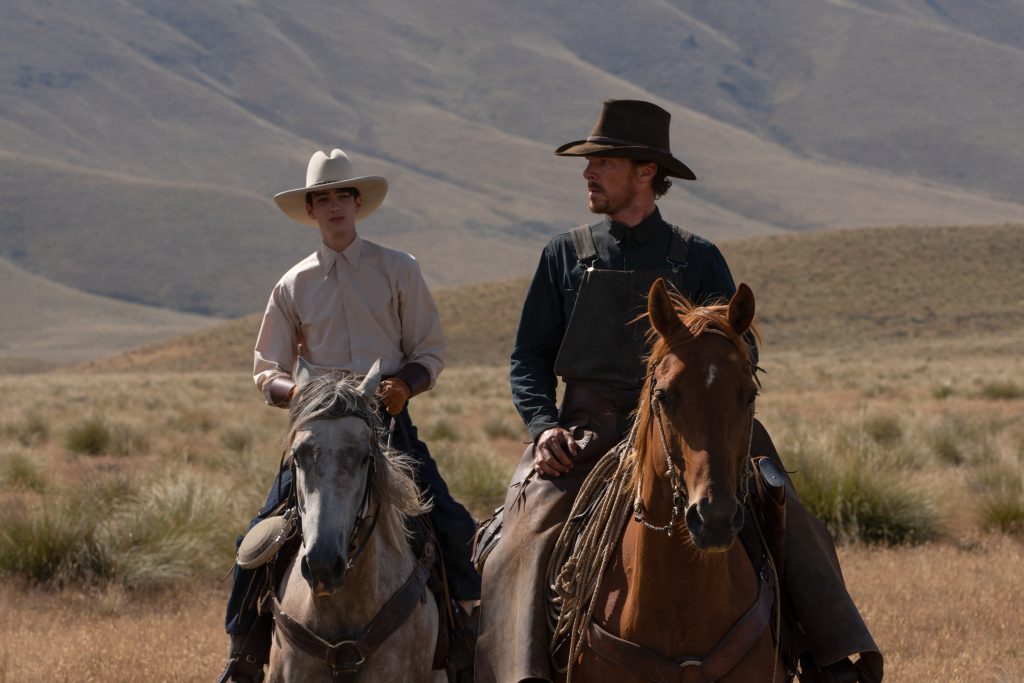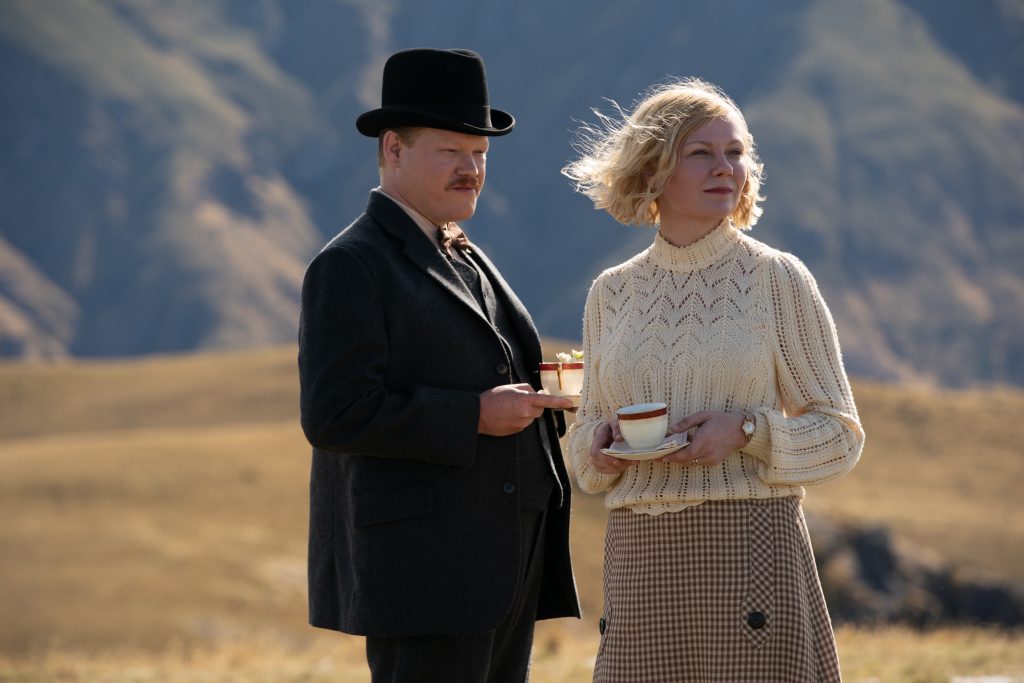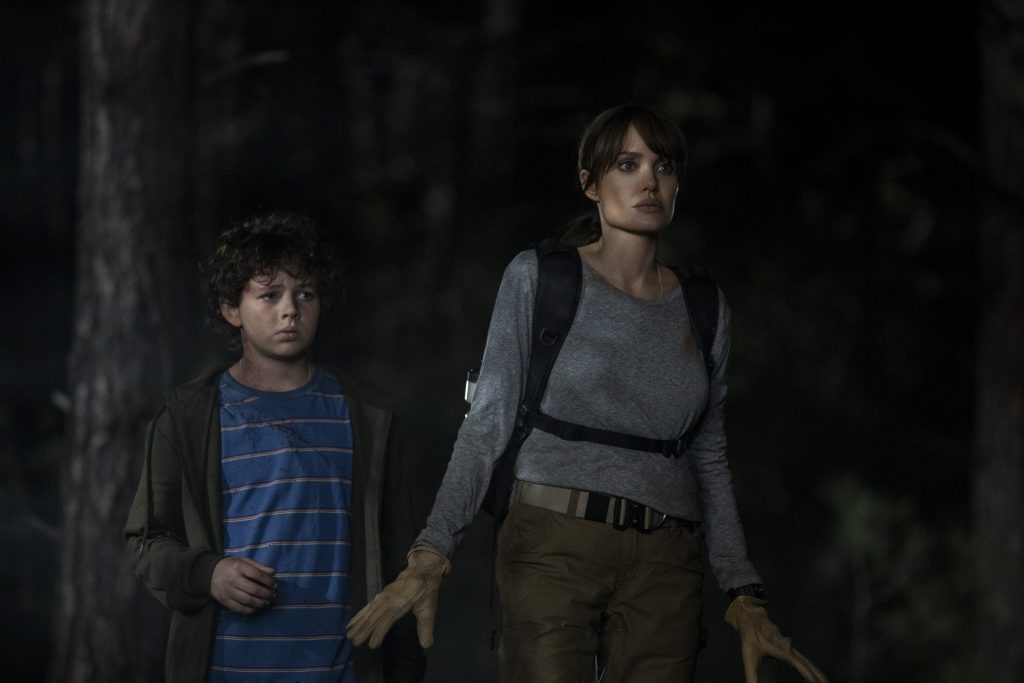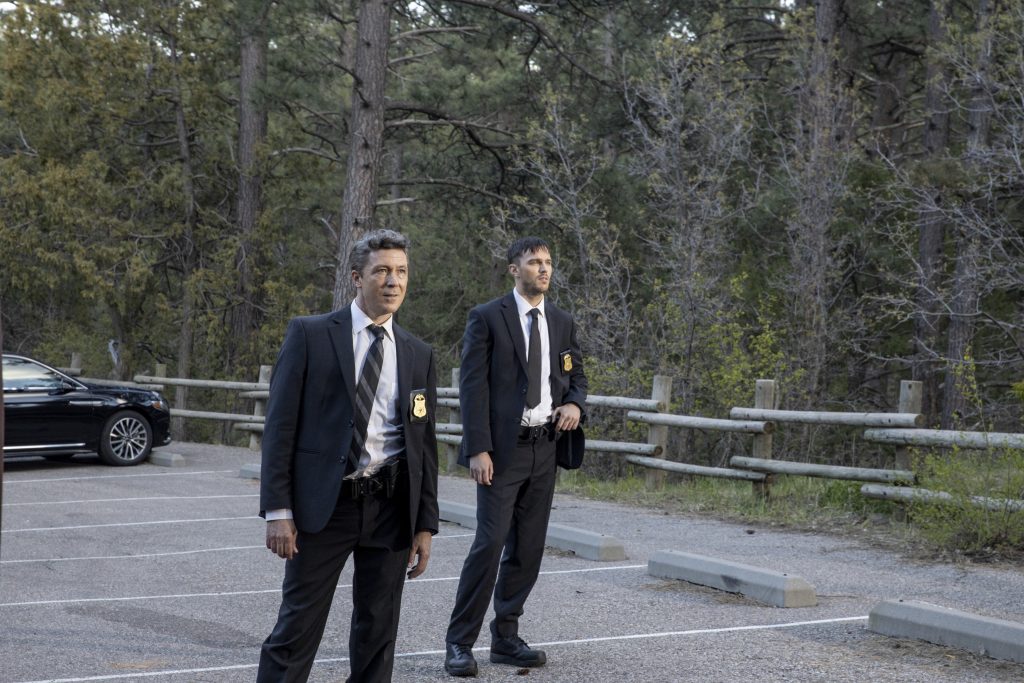April 12, 2022
by Carla Hay
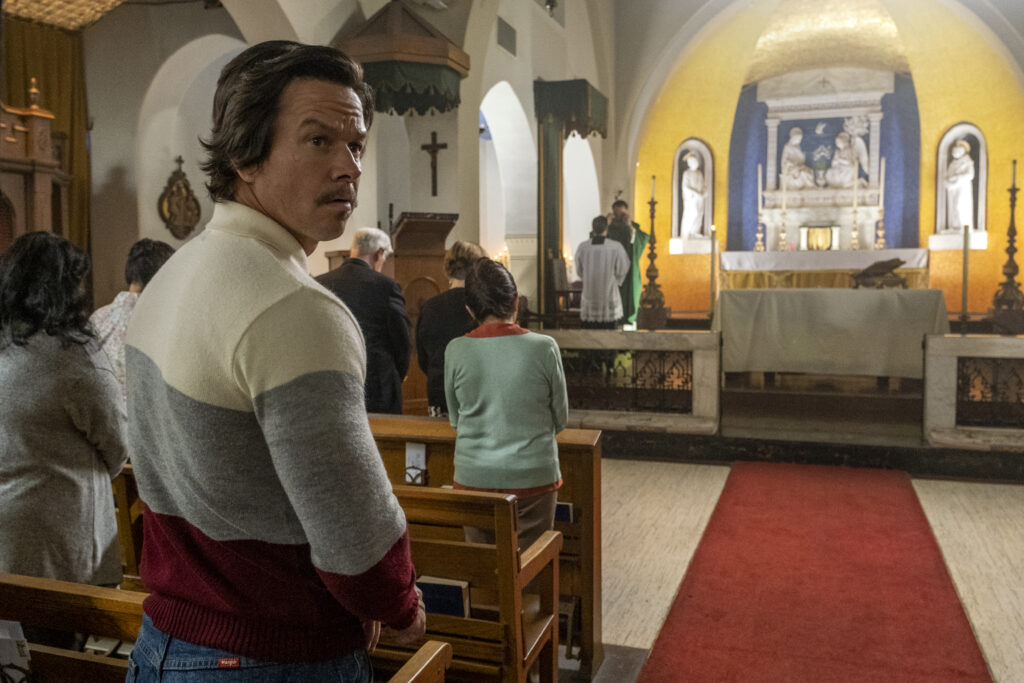
Directed by Rosalind Ross
Culture Representation: Taking place from the mid-1990s to late 2000s in Los Angeles and Helena, Montana, the dramatic film “Father Stu” features a cast of predominantly white characters (with a few African Americans, Latinos and Asians) representing the working-class and middle-class.
Culture Clash: A washed-up amateur boxer, who has a history of committing violence and other crimes, moves from Montana to Los Angeles to become an actor, but he ends up becoming a priest.
Culture Audience: “Father Stu” will appeal primarily to fans of star Mark Wahlberg and people who like formulaic dramas about toxic masculinity where men are excused and forgiven for things that women would not be allowed to get away with as easily.
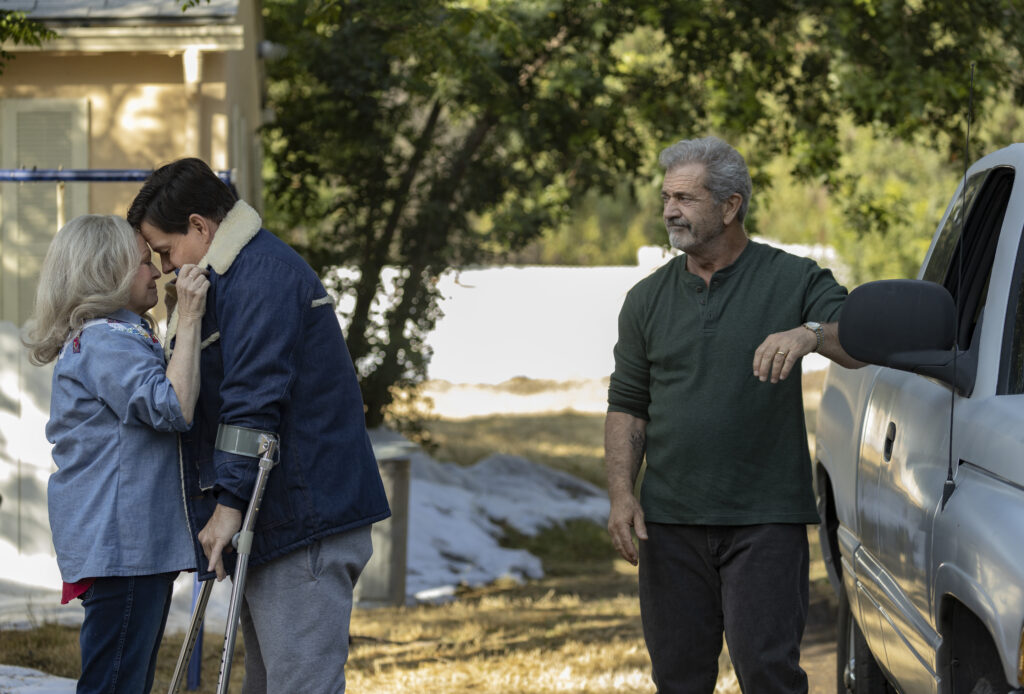
Boring and predictable, “Father Stu” is yet another film in Mark Wahlberg’s long list of one-note movies where he plays a foul-mouthed jerk who’s promoted as heroic. It’s another “toxic male who needs to be redeemed” story that does nothing new or clever. This tired retread has the word “flop” written all over it.
“Father Stu” is the feature-film debut of writer/director Rosalind Ross, who pollutes this movie with a lot of corny dialogue and cringeworthy scenarios. “Father Stu” is based on a true story, but so much of this biographical film looks phony because of the contrived ways that the characters speak and act. And the movie looks like it was made by people who’ve seen too many outdated TV-movie dramas and decided to rehash and dump the same formulas into this dreadful dud.
In “Father Stu,” Wahlberg (who is one of the movie’s producers) plays Stuart “Stu” Long, an aggressively obnoxious loser who decides to commit to Catholicism and becomes a priest after experiencing a health crisis. The movie takes place from the mid-1990s to the late 2000s, when the real Long was in his early 30s to mid-40s, although Wahlberg never looks convincing as someone in his 30s.
“Father Stu” starts off in Stu’s hometown of Helena, Montana, where he is an amateur boxer who’s never made it into the big leagues. While in his early 30s, Stu is seen in a doctor’s appointment with his devoted and sometimes sarcastic mother Kathleen Long (played by Jacki Weaver), when they get some bad news: The doctor says that Stu’s boxing injuries are life-threatening, and he will die if he doesn’t quit boxing.
Stu takes his anger out on his mother, by berating her for having him at this doctor’s appointment where Stu got news that he didn’t want to hear. When she tactfully tells Stu that she’s heard about an oil rig job that’s hiring, Stu snaps at her: “I ain’t doing no blue-collar bullshit!” Meanwhile, Stu (who is a bachelor with no children) hasn’t really figured out what he’s going to do to earn an income.
Even though “Father Stu” is written and directed by a woman, this stale excuse for a movie repeats all the clichés of misogynistic movies where women with significant speaking roles only exist as a banal “mother” or “love interest,” rarely with fully formed personalities. In these sexist movies, all of the action revolves around men, and the women are just there to react to whatever the men do. And that’s exactly what happens in “Father Stu.”
Soon after his boxing career ends, Stu decides he wants to move to Los Angeles and become an actor. (In real life, Stuart Long moved to Los Angeles in 1987, when he was 24.) Before Stu moves to L.A., he visits the grave of his younger brother Stephen Long, who died in 1971, at the age of 5 years old. (Stephen’s death is eventually talked about in more details.) It’s at this point, in this movie’s graveyard scene, that you know the filmmakers are going to use this tragic death as a way to garner sympathy for Stu and all the offensive and selfish things that he does.
While a drunken Stu is at the grave, he hallucinates seeing himself as a boy of about 9 or 10 years old (played by Tenz McCall), in a hokey moment that’s supposed to make viewers literally see Stu’s inner child. The adult Stu gets angry and punches a nearby statue of Jesus Christ. And just at that moment, a police car drives up. Viewers don’t see what happened between Stu and any cop on the scene, but it’s shown later that Stu was arrested for resisting arrest. The movie goes out of its way to erase or gloss over any crimes that he commits.
Instead, Stu is presented as someone who goes through life insulting others and who doesn’t hesitate to bully people to get what he wants. The movie tries to excuse his awfulness by showing that Stu comes from an emotionally damaged family: Stu’s younger brother died tragically, and Stu’s parents are estranged from each other. Stu is infuriated at his father for being what Stu calls a “deadbeat dad.” Stu is a lot more like his father than Stu would care to admit.
Stu’s father William “Bill” Long (played by Mel Gibson) is a truck driver, who passed on a lot of his bad personality traits to Stu. They are both crude, ill-tempered and quick to instigate fights where they curse at people or get violent. (And yes, you can do a countdown to the inevitable scene where Stu gets in a bar fight.) Stu’s mother Kathleen has gotten fed up with Bill, so they are no longer living together.
As an example of how “Father Stu” rips off familiar territory, Gibson and Wahlberg did another version of this “rude father and son” schtick in the 2017 annoying comedy film “Daddy’s Home 2.” Gibson is also probably in “Father Stu” because of his romantic relationship with “Father Stu” writer/director Ross. The couple began dating in 2014.
One thing that Stu’s parents both agree on is that Stu’s goal of becoming a professional actor is a foolish and unlikely dream. And sure enough, when Stu moves to L.A. and makes the rounds at talent agencies, he’s rejected. Viewers don’t see a lot of these rejections, but Stu mentions it in a scene where a lecherous male agent sexually propositions Stu when the two of them are alone together in the agent’s office. An angry Stu then roughs up this sexual predator and breaks a video camera in the office before slamming the door when he leaves.
Stu can’t get work as an actor, so he takes a job working behind the meat counter at a grocery store. In his desperate attempts to break into showbiz and make connections, Stu has an irritating and unprofessional habit of asking customers while he’s working if they’re in the entertainment business. It’s at this grocery store where he meets Carmen (played by Teresa Ruiz), a devoutly religious Catholic who becomes Stu’s love interest before he becomes a priest. It’s infatuation at first sight for Stu, who tries to flirt with Carmen when they first meet, but she’s not impressed.
“I didn’t catch your name,” Stu tells Carmen before she walks away. “You’re not much of a fisherman,” Carmen says coyly, as if she thinks it’s hilarious to make a reference to the phrase “fisherman’s catch.” This is the type of dumb dialogue in “Father Stu” that will have audiences rolling their eyes at how cornball this movie is.
Carmen left behind a church flyer with the store manager, so that’s how Stu finds out where Carmen goes to church. Soon enough, Stu shows up at the church like a stalker, and that’s how he discovers that Carmen is a Sunday school teacher at this Catholic church. At this point in Stu’s life, he’s a lapsed Catholic. Guess who’s going to be a regular attendee of this church? Guess who’s now going to want to look like a devoted Catholic? It’s Stu’s way of trying to charm Carmen into dating him.
Stu tells people that Carmen is “the love of his life” and his “future wife” shortly after meeting her. One of these people is the church’s Father Garcia (played by Carlos Leal), who is skeptical about Stu’s interest in Catholicism, but nevertheless has to listen to Stu’s rambling, self-indulgent diatribes when Stu does confessionals with Father Garcia. These confession scenes are very tiresome and have all the emotional resonance of air being let out of a windbag.
Carmen slowly falls for Stu, but then he gets into a horrific motorcycle accident where he is struck by a car and nearly dies. During his recovery, Stu and Carmen begin a sexual relationship, and she seriously starts to think that they will get married. But not so fast, Carmen. Stu has a religious epiphany and tells Carmen that he wants to become a priest during a conversation that she thought would be a marriage proposal to her. None of this is spoiler information, of course, because anyone who’s aware of this movie’s title should know what Stu’s vocation ends up being.
Carmen doesn’t take the news well at all. “You’re setting yourself up for failure,” Carmen tells Stu. She also calls Stu “delusional,” as she tearfully ends this conversation. But Carmen’s feelings are sidelined because the movie is on a mission to show the dubious redemption of Stu, as he goes from being a rough-talking hooligan to a rough-talking priest.
Stu’s father Bill also thinks Stu’s decision to become a priest is some kind of pathetic joke, just like the line that Bill delivers when he hears the news. Bill reacts to the news of Stu wanting to join the Roman Catholic priesthood by saying: “It’s like Hitler asking to join the ADL [Anti-Defamation League].” Considering that Gibson nearly ruined his career and permanently tarnished his reputation with his anti-Semitic rant during his 2006 arrest for drunk driving, it’s in very bad taste to have him tell a Hitler “joke” in a movie.
“Father Stu” then has numerous trite scenes where Stu is shown as a seminary “misfit” who’s determined to prove his naysayers wrong. Among those who don’t think that Stu has what it takes to become a priest is an uptight and pious seminary student (played by Cody Fern), who is the opposite of Stu in almost every way. Predictably, these two are forced to share the same sleeping quarters when they’re assigned to be roommates in their seminary.
Stu also shows that he’s racist against black people, when he expresses some bigoted points of view while interacting with an African American seminary student named Ham (played by Aaron Moten), who is a lot more patient with Stu than Stu deserves. Ham is essentially one of many characters who let Stu walk all over them and manipulate them. When Stu first meets Ham, he ridicules Ham for his name. Stu is so ignorant, he thinks the name Ham is some kind of “ethnic” thing.
Later, when Stu gets Ham to play basketball with him in their free time, Stu mocks Ham for not being as good at basketball as Stu expected. Stu literally says in the movie that he thinks Ham should be better at basketball because Ham is black. The scene is played for laughs, but it’s a putrid, tone-deaf scene where Stu never gets called out for his racism.
In addition to having a roommate that he despises, Stu also contends with a supervising teacher named Monsignor Kelly (played by Malcolm McDowell), who is a stereotypical stern priest who wants everyone to be as strictly religious as he is. Not surprisingly, Monsignor Kelly doubts that Stu is really serious about becoming a priest, so the two men inevitably clash with each other.
Time and time again, “Father Stu” spins Stu’s boorishness as being a freewheeling rogue who’s an underdog and underestimated by people around him. However, it just exposes the sexism in many aspects of society. After all, women who are this loathsome and violent probably wouldn’t be allowed to become Catholic nuns. And if they did, they certainly don’t get movies made about them.
“Father Stu” is essentially a vanity showcase for Wahlberg to play the same type of character that he’s been playing for years: cranky, argumentative and quick to step on people to get what he wants. Everyone else in “Father Stu” is just a two-dimensional sidekick in this tedious parade of enabling toxic masculinity, where the man who’s supposed to be redeemed gets many chances to turn his life around, while audiences are supposed to be cheering for him every step of the way. Needless to say, nothing about this movie is award-worthy, and lot of it is just a chore to watch.
Of course, the redemption of Stu also comes with a life-threatening disease: inclusion body myositis, so that audiences can feel even more sympathy for him. Unfortunately, in “Father Stu,” this disease is used as just another plot device to prop up Stu’s redemption arc. “Father Stu” is essentially a half-baked project that looks like a second-rate TV-movie. It certainly isn’t worth watching for the price of a movie ticket.
Columbia Pictures will release “Father Stu” in U.S. cinemas on April 13, 2022.
UPDATE: A new, PG-13 version of “Father Stu” will be released under the title “Father Stu: Reborn” in U.S. cinemas on December 9, 2022. The original version of “Father Stu” is rated R.

